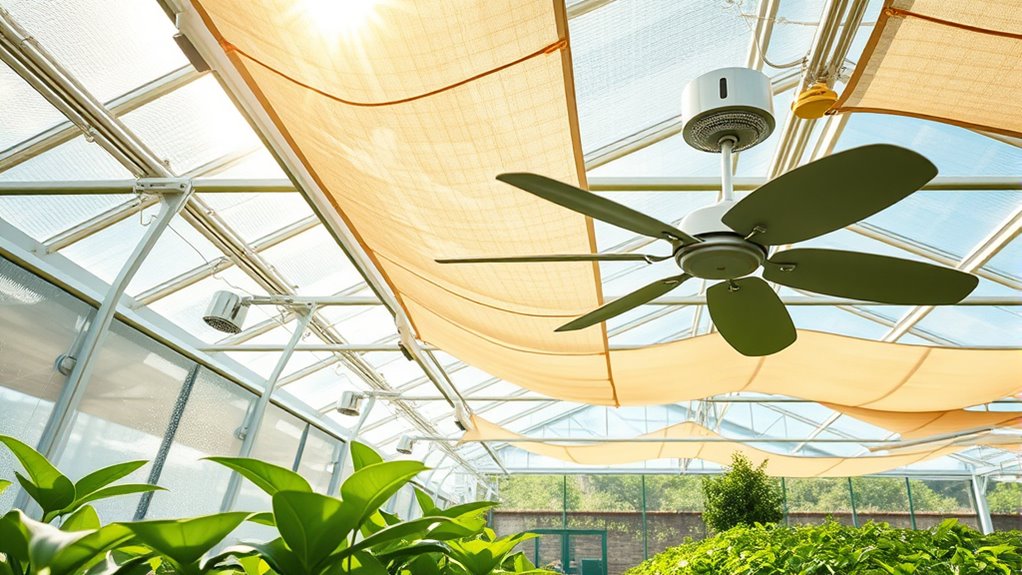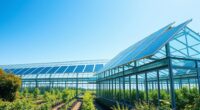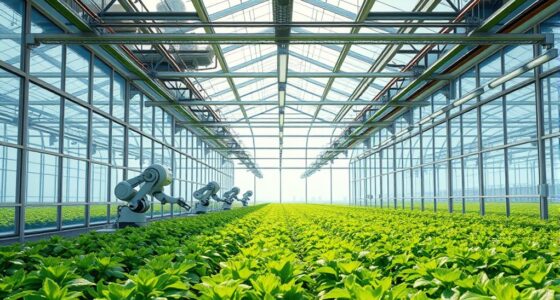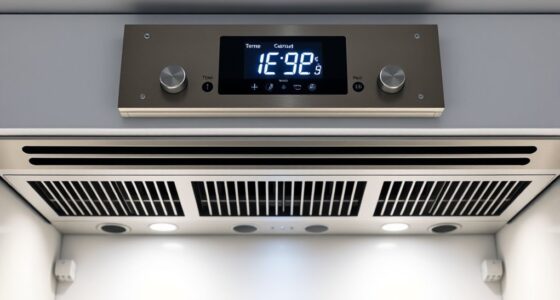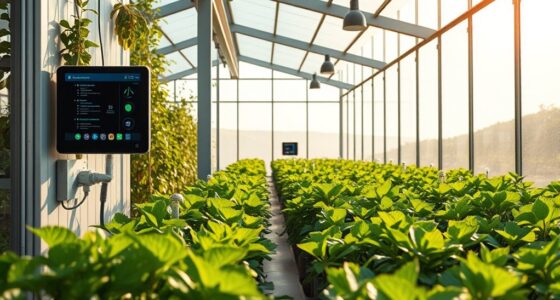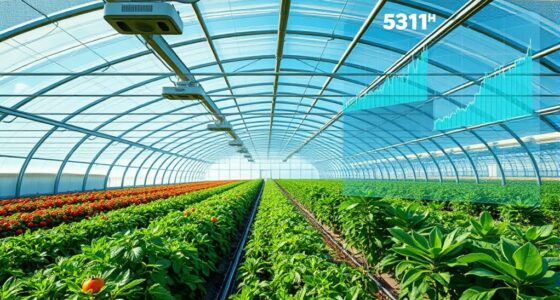To keep your greenhouse cool in summer, combine evaporative cooling methods like misters or pads with passive ventilation such as roof and side vents that promote natural airflow. Reflective roofing and shading devices reduce heat gain, while materials that bounce heat help maintain ideal conditions. Using thermal mass can stabilize temperatures, and regular maintenance guarantees efficiency. Exploring these innovative strategies will help you create a more comfortable environment for your plants during hot months.
Key Takeaways
- Combine passive ventilation with evaporative cooling for energy-efficient, consistent greenhouse temperature control.
- Use reflective roofing and shading devices to minimize heat gain during hot summer days.
- Incorporate thermal mass materials to absorb heat and stabilize internal temperatures overnight.
- Design strategic vent placement to promote natural airflow and enhance passive cooling effects.
- Regularly maintain and monitor cooling systems to optimize performance and prevent humidity issues.
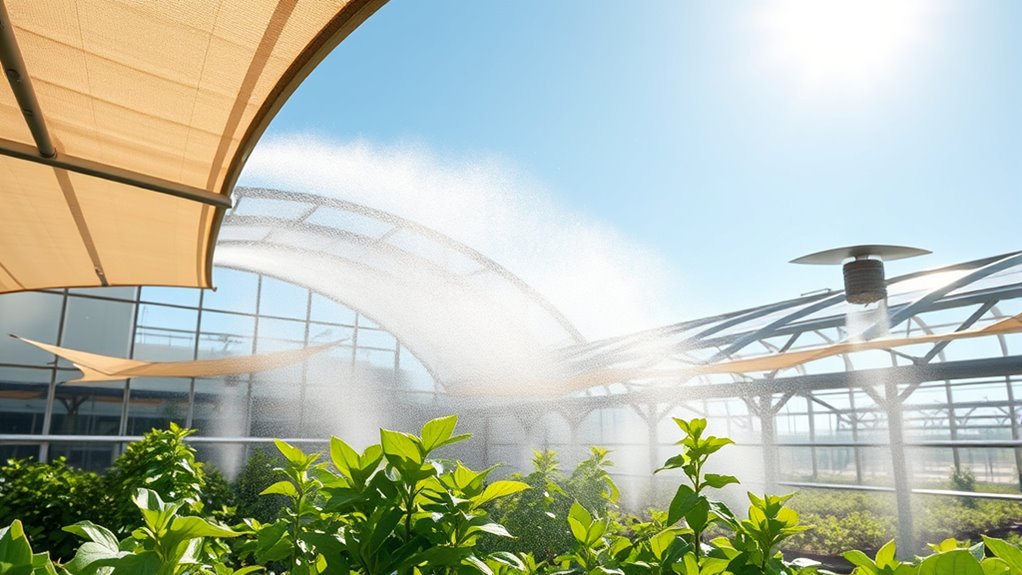
Greenhouses can quickly become overheated, especially during hot summer days, which can stress plants and reduce yields. To combat this, innovative cooling techniques like evaporative cooling and passive ventilation are essential tools in your gardening arsenal. Evaporative cooling works by adding water to lower the temperature inside your greenhouse. When water evaporates, it absorbs heat from the surrounding air, effectively reducing the temperature. You can implement this by using wet walls, misters, or evaporative pads. These systems are energy-efficient and work best in dry, hot climates, providing a consistent cooling effect without the need for complex machinery.
Evaporative cooling lowers greenhouse temperatures by absorbing heat through water evaporation, ideal for dry, hot climates.
Passive ventilation is another effective approach that doesn’t rely on electricity. It involves designing your greenhouse to naturally promote airflow, which helps dissipate heat build-up. By installing roof vents, side vents, or operable windows, you allow hot air to escape and cooler air to enter naturally. Proper placement and size of these vents are vital; you want to create a pressure difference that encourages continuous airflow. When airflow is well-managed, it can considerably lower interior temperatures, creating a more stable environment for your plants. Combining passive ventilation with shade cloths or reflective coatings can further enhance cooling, especially during peak sunlight hours.
You should consider integrating both evaporative cooling and passive ventilation to maximize cooling efficiency. For example, during the hottest parts of the day, you can open vents to promote airflow while running an evaporative system to provide additional cooling. This synergy helps maintain a consistent, ideal temperature that prevents heat stress and encourages healthy plant growth. It’s also important to monitor humidity levels because evaporative cooling can increase moisture in the air. If humidity becomes too high, it might promote mold or fungal issues, so balancing these systems is key.
In addition, choosing appropriate materials for your greenhouse construction can significantly influence its thermal regulation capabilities, as certain materials reflect heat better than others. Furthermore, considering the architectural design of your greenhouse can significantly influence its thermal regulation, as well-designed structures can naturally reduce heat gain and improve airflow. In addition to these methods, think about the design of your greenhouse. Using materials that reflect rather than absorb heat, such as light-colored or reflective roofing, can reduce heat gain. Incorporating shading devices like retractable shades or shade cloths can block excessive sunlight during the hottest parts of the day, minimizing heat buildup. Regularly inspecting and maintaining your ventilation and evaporative systems ensures they operate efficiently when needed most. Additionally, implementing thermal mass within your greenhouse can help absorb excess heat during the day and release it at night, stabilizing internal temperatures.
Frequently Asked Questions
How Do Evaporative Coolers Compare to Traditional Air Conditioning?
When comparing evaporative coolers to traditional air conditioning, you’ll find evaporative coolers often have higher evaporative efficiency, making them energy-efficient in dry climates. They use less power and are easier to maintain, but require regular cooling system maintenance to prevent mineral buildup and guarantee peak performance. Traditional AC units provide consistent cooling regardless of humidity, but they tend to consume more energy and involve more complex maintenance.
Can Natural Ventilation Alone Maintain Optimal Greenhouse Temperatures?
Natural ventilation can help you maintain greenhouse temperatures, but it often isn’t enough alone during hot summer days. To succeed, you need to focus on airflow enhancement — strategically placing vents and using fans to enhance natural airflow. This method can reduce reliance on mechanical cooling, but for consistent, ideal temperatures, you might still need supplementary cooling techniques, especially during extreme heat spells.
What Are the Energy Costs of Different Cooling Methods?
You might think cooling methods cost a fortune, but the truth is, some are surprisingly affordable! When you compare costs, natural ventilation is the absolute champion for energy efficiency, saving you big bucks. Evaporative coolers and misting systems use more energy, increasing expenses. So, you can keep your greenhouse cool without draining your wallet, just by choosing the right technique based on a smart cost comparison and energy efficiency.
How Do Shading Techniques Impact Plant Growth and Cooling Efficiency?
Shading techniques considerably influence plant growth and cooling efficiency through effective shade management and light diffusion. By carefully controlling the amount and quality of sunlight, you can prevent overheating and reduce energy costs. Proper shading guarantees plants receive ideal light for growth while diffusing excess radiation, creating a cooler environment. This balance enhances plant health, maintains consistent temperatures, and maximizes cooling efficiency, ultimately supporting a productive greenhouse operation.
Are There Eco-Friendly Refrigerants Suitable for Greenhouse Cooling Systems?
You’re on the right track by exploring eco refrigerants for greenhouse cooling systems. Eco refrigerants, like hydrofluoroolefins (HFOs), and green coolants, such as CO2 and ammonia, are sustainable options that don’t harm the environment. Think of it as killing two birds with one stone—keeping your greenhouse cool while reducing carbon footprint. These eco-friendly solutions are gaining ground, making your cooling systems both effective and planet-friendly.
Conclusion
By implementing innovative cooling techniques, you can keep your greenhouse temperatures manageable even during peak summer heat. Did you know that proper cooling can increase plant growth rates by up to 30%? That’s a significant boost for your crops and your bottom line. Whether you choose ventilation, shading, or misting systems, staying proactive guarantees healthier plants and higher yields. So, embrace these methods to keep your greenhouse cool and your plants thriving all summer long.
